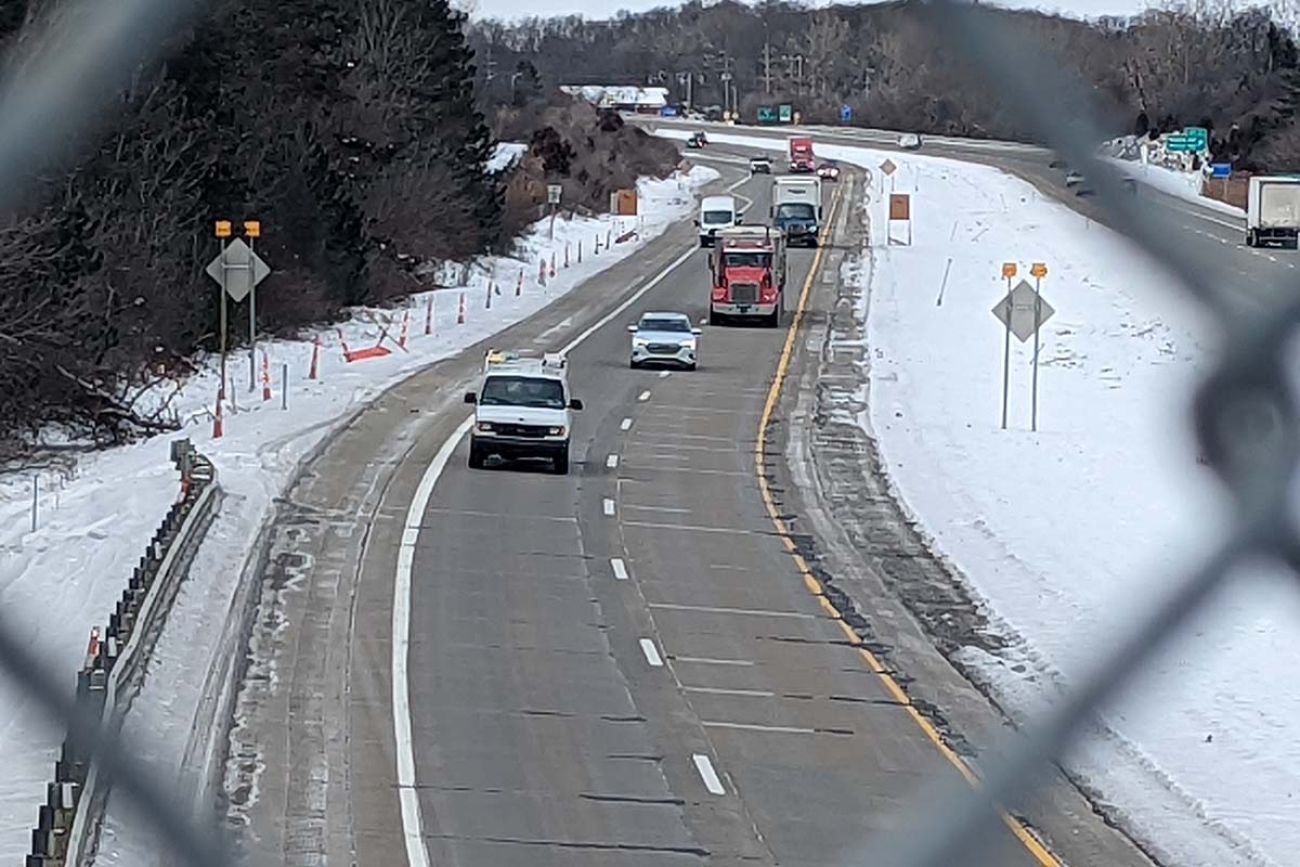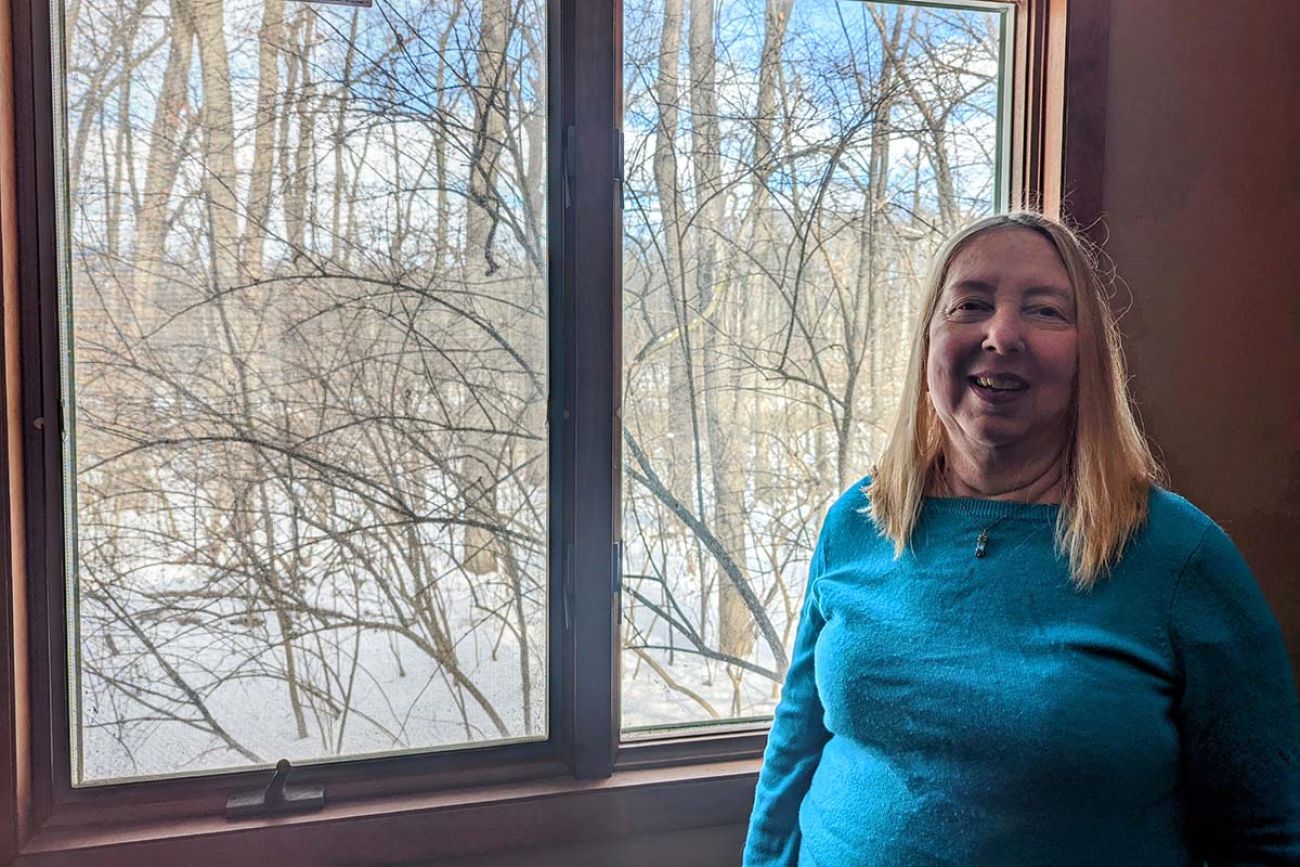Michigan’s lousy infrastructure has many begging: Fix the damn noisy roads

- Residents in Ann Arbor, Troy and other Michigan communities have formed groups asking government to help with freeway noise
- Petitions have resulted in more studies to reduce noise, but it’s an expensive process
- Other states are testing new materials for noise barriers and trying out other options to try and keep the noise down
ANN ARBOR — Deborah Orlowski doesn’t need Siri to tell her what traffic is like on the M-14. She can hear it from inside her house.
A small thicket of bushes and trees separates her property from the M-14, a state freeway that stretches from Interstate 94 in Washtenaw County to Interstates 96 and 275 in Wayne County. But landscaping does little to cushion the near-constant whoosh of cars and trucks.
“It's a nice alarm clock — we know exactly when it's 5:30 (a.m.), because that's when you start to hear the traffic noises again,” she said.

About an hour northeast in Troy, Loraine Scussel and her neighbors are all too familiar with such racket. They live just over half-mile from Interstate 75 and had no issues with noise before summer 2019, when construction on a $1.3 billion project to widen Interstate 75 removed trees that had blocked out highway noise. Since then, they say it’s been inescapable.
Related:
- Michigan lawmakers raise concern about toll road plan
- Gov. Gretchen Whitmer open to charging tolls on Michigan roads
- Highway tolls could raise $1B to fix Michigan roads, study finds. Is it time?
“Everyone is passionate about the negative impact the traffic noise has created in their lives,” Scussel said, noting that she went from having no experience in local politics to spending 15 to 20 hours a week reaching out to anyone who will listen.
For years, much of the debate in Michigan has been about finding money to fix the damn roads. But now that Gov. Gretchen Whitmer is amid a $3.5 billion, five-year road building blitz, lawmakers increasingly are getting earfuls about highway noise and trying to get creative about silencing the din.
The most common solution to traffic noise has been building concrete noise barriers. But they’re big, cost millions per mile to build, and often don’t work as well as expected.
Some states and nations are experimenting with different materials such as vinyl barriers, but for now, most Michigan lawmakers are opting for traditional solutions, such as paying for noise studies in hopes of securing more federal money for concrete barriers.
It’s not just a minor annoyance for many residents left to live with the noise.
Research has shown that sustained exposure to loud noise can cause serious health issues, including chronic sleep disruption, permanent hearing loss, and even heart attacks.
A recent Rutgers University study found the heart attack rate was 72 percent higher for New Jersey residents in places with high transportation noise exposure, linking one in 20 heart attacks to elevated noise levels.
Orlowski said her son needs to keep a fan or heater going in the house for white noise while he sleeps. She’s resorted to sleeping with a pillow over her head to cover her ears.
“That's pretty pitiful, isn’t it? I’ve never thought of that before, but geez, here I am trying to sleep in the house and I have to put a pillow over my head,” she said, chuckling.
The cost of quieter roads
Tom Zurberg, the Michigan Department of Transportation’s noise specialist, said he gets at least one or two inquiries from citizens every month about noise issues in their communities.
Most of the time, he said, he has to tell them there’s not much the state can do if the road already exists or isn’t actively under construction.
“There isn’t a program that's designed and set up to provide noise abatement per citizen request,” he said. “We don't get the funding to study the noise unless we have a qualifying project. So that's a real challenge when people call in and say, ‘I want a noise barrier,’ and it's like, ‘Well, I wish I had better news for you.’”
The Federal-Aid Highway Act of 1970 requires states to analyze noise impacts when constructing new projects. The Federal Highway Administration provides federal funding for noise barriers under its “Type I” program if a residential area meets a slew of criteria under a traffic noise study, including proximity to the roadway, population density and a sustained average noise level of 66 decibels or more.
That’s a little louder than an average conversation and a little quieter than a washing machine.
The World Health Organization recommends an average of 53 decibels or lower for road traffic noise exposure and less than 45 decibels for night noise exposure, meaning some areas considered noisy enough to cause health problems might get overlooked under federal guidelines.
Some states, including Ohio, Massachusetts and New Hampshire, take advantage of a second, voluntary “Type II” program that allows states to build noise barriers for existing residential areas near highways. Residents can submit an application to see if their communities qualify for such a project in participating states. .
The catch? States have to foot the bill on those projects. Michigan indefinitely suspended its Type II program on Dec. 10, 2007, due to budget constraints.
One factor contributing to noisy roads — the “thunk” of cars and trucks hitting potholes — is a big part of the reason quieting down traffic noise hasn’t been the top priority.
Infrastructure experts have been sounding the alarm for years about chronic underfunding of Michigan’s crumbling roads. In 2016, a commission appointed by then-Gov. Rick Snyder projected the state needed to boost spending by more than $2 billion annually to reverse ongoing deterioration.
The state’s Transportation Asset Management Council projects 44 percent of roads will be in poor condition by 2030, up from 42 percent in 2020.
“We believe that we've exacerbated the problem,” said Lance Binoniemi, vice president of government affairs for the Michigan Infrastructure and Transportation Association. “We’ve had a significant amount of investment, but those are very short term.”
Although most projects attempt to have some noise mitigation, there’s usually not much flexibility in the budget to invest in barriers or other abatement measures beyond federal guidelines, especially with skyrocketing costs of cement and other building materials, Binoniemi said.
Even if every road in Michigan were new, it wouldn’t cut out traffic noise entirely, Zurberg said. Particularly in major metropolitan areas, several lanes of high-volume traffic are just going to be noisy.
“Anybody living next to it is still going to hear that tire-pavement interaction of all those vehicles,” he said. “It’s just a little bit different sound compared to the bouncing, banging pothole one, it's more of…a roar or a din.”
The ‘squeaky wheel’
In both Troy and Ann Arbor, residents say the noise has gotten worse in recent years.
Interstate 75 construction “immediately impacted the sound levels” in several Troy neighborhoods, Troy Mayor Ethan Baker said.
Troy residents’ activism got them further than most — in the previous state budget, $300,000 was approved for an updated noise study that takes current traffic into account. A subsequent appropriation in a broader infrastructure package allocated $4 million for the project if the study finds federal criteria are met. Those results are expected to be made public this spring.
“These residents are really, really hurting and trying to have some faith that those who represent them in government can help them,” he said. “But they're losing faith, I think, in many ways. And that's sad to me.”
Funding for similar noise analyses was approved for a segment of Interstate 75 in Southgate and the Interstate 475 and Interstate 69 interchange in Flint. The results of those studies are intended to determine whether the communities qualify for additional noise barriers under federal guidelines.
Residents who live near M-14 hope they could be the next to get financial help from the state.
Bobby Gregg, the de facto leader of a citizens’ campaign for improving traffic noise conditions between Interstate 94 and US-23, said he and others in the community are advocating for a full reconstruction to fix the concrete surface, the source of most of the noise.
The condition of the road is “unlike anything I've ever seen,” he said, noting that when he drives that section of the road, he can barely hear the radio in the cabin of his car.
After Michigan officials denied a request from Ann Arbor city officials and residents to address noise concerns in the area, Gregg said he intends to be a “squeaky wheel” and keep asking lawmakers for help.
He’s particularly concerned about traffic noise near Wines Elementary School, where his personal decibel measurements have shown noise can exceed 90 decibels — about as loud as a blender at top power.
A separate state fund or process dealing specifically with noise remediation would immensely help, said Baker, Troy’s mayor, noting his residents spent months just trying to figure out where to direct their concerns.
“We need to make a concerted effort to acknowledge that noise pollution is real and affects the quality of life of our residents,” he said.
Issues with traffic noise aren’t limited to neighborhoods near major freeways.
In southwest Detroit, large semi trucks frequently cut through neighborhoods, many of which are being rerouted due to construction on the new Gordie Howe Bridge to Windsor.
Research led by the University of Michigan and the Southwest Detroit Community Benefits Coalition found that the community was subject to an average of 62.1 decibels of noise exposure every weekday.
“It’s like you’re living on a highway,” longtime southwest Detroit resident Thomasenia Weston told researchers, adding that she would move somewhere else if she thought her home would sell.
House Transportation Chair Nate Shannon, D-Sterling Heights, said he’s had talks about highway noise with new Rep. Sharon MacDonell, a Troy Democrat who represents many impacted residents near I-75.
He’s willing to have the conversation about how traffic noise is addressed, and wants to be receptive to constituent concerns. But he noted that with so many pressing infrastructure needs, a long-term state fix for noisy roads could be a ways off.
“All these things cost money, and we need to continue to fix roads and make roads better,” he said. “Money that’s going to come to deal with noise…is going to be money that’s not going to be put towards the roads.”
Reducing the racket
The most effective way to make roads less noisy is to start at the source, Les Blomberg, a national noise expert, told Bridge Michigan.
The typical order noise experts recommend when reducing noise impact is first, making the source noise quieter, then trying to block the path of the noise, and finally, insulating the listener from the noise if all else fails, he said.
Blomberg is the executive director of the Vermont-based organization Noise Pollution Clearinghouse, a nonprofit that aims to raise awareness about noise pollution and advocate for a society that’s, well, quieter. Long-term, electric cars, trucks and buses could help reduce the racket, he said.
Other potential options include experimenting with quieter pavement materials, incentivizing noise-reducing tires and going after the “worst offenders,” such as drivers of cars and motorcycles who use aftermarket parts to increase the sound of their vehicles.
“These are not problems that are unsolvable,” Blomberg said. “These are problems for which currently there's a lack of political will or there's too much power wielded by the noisemakers to solve them. But we have the technology.”
Noise barriers such as sound walls are the next best option short of quieting the traffic noise itself, working to block the path of the noise from reaching nearby residents. But the large barriers aren’t the best option for every community.
At both the state and federal level, noise barriers are king when it comes to noise mitigation strategy — but the expense of putting them up and stringent federal guidelines can be barriers of their own.
According to the nonprofit news site Undark, the efficacy of sound walls can vary greatly based on factors like how far away homes are from the barriers, weather conditions and whether there are any gaps in the wall that could let sound through.
Michigan has about 75 miles of noise barriers, MDOT officials say, a modest amount compared to other states. According to the Federal Highway Administration, there are nearly 3,000 linear miles of sound walls nationwide, and California alone has 760 miles of them. Ohio, Michigan’s Midwest neighbor, has at least 242 miles of noise barriers in place and more planned.
Overall costs and federal government subsidies for traditional sound walls have left little incentive to invest in other options, but some states are experimenting with other alternatives. The Ohio Department of Transportation recently studied the feasibility of vinyl noise barriers — a cheaper alternative to concrete — and the possibility of using sections of “green noise wall” covered in vegetation to absorb sound and improve air quality.
Noel Alcala, a noise wall expert for the Ohio transporation department, said the agency is considering vinyl fencing on a case-by-case basis, adding that vegetation would only be used as a visual screening, not as an alternative to barriers.
In 2018, University of Michigan researchers published findings on the potential of an “origami” structure that could be reconfigured for different traffic noise frequencies to reduce noise more effectively.
Scussel and other Troy residents working to reduce the noise I-75 updates brought to their neighborhoods welcome the idea of experimentation in their community. If a wall is too expensive or won’t resolve the problem, they told Bridge they want other options.
One resident, retired engineer Mitchell Puskarz, has compiled his own noise measurements and is evaluating each section of the freeway adjacent to Troy to determine the unique noise issues and possible ways to address it in a cost-effective way that doesn’t exacerbate the problem.
“It’s not like a matter of reinventing the system. The fundamental aspects of physics for solving this problem have been there for years,” Puskarz said. “Somebody needs to take a strong position and say, ‘OK, let’s use this site as an example. Let’s change the parameters.’”

‘Fleeing the noise has not worked’
Some municipalities and states have tried legislation aimed at regulating noise from the vehicles directly, with mixed results.
In New York, legislation known as the “SLEEP Act” was signed into law in 2021 and is aimed at reducing noise and emission pollution by increasing fines for illegally modifying exhausts to make them louder and requiring additional muffler and exhaust inspections for motorcycles.
Local governments in Michigan that have tried to keep car noise down have been met with stiff resistance. The city of Royal Oak, located along the heart of the Woodward Dream Cruise, backed off its enforcement of a strict noise ordinance after drivers who got tickets for their loud vehicles threatened legal action.
Sen. Mallory McMorrow, D-Royal Oak, helped secure noise study funding for Troy residents and frequently hears complaints about noise from people along the Woodward Avenue corridor.
She said that while bans or restrictions on aftermarket auto parts is likely a “nonstarter” in a state that’s home to the Motor City, the issue points to the need for a broader conversation about what a more holistic infrastructure system looks like.
“We understand we need highways, we want people to get from point A to point B, it's economically advantageous for us,” she said. “But I do think that we should be considering quality of life, air pollution, noise pollution, all those sorts of things whenever we're reviewing any of these projects.”
McMorrow also expressed concern that the current process of lobbying lawmakers for attention means municipalities that have more time and resources are more likely to get their issues addressed, while communities with fewer resources could be left out of any fixes.
From a planning perspective, Zurberg said the state works to align new builds as far away from neighborhoods as possible. He also recommends local governments keep noise issues in mind when reviewing zoning ordinances and approving locations for new residential developments.
Orlowski, who has been an Ann Arbor resident since 1983 and lived near Wines Elementary School before moving to her current residence, wishes things were different, but doesn’t want to give up on her home.
When she initially moved into her current house, Orlowski said, “I looked up and down the street and I started to cry, and said, ‘I can't believe that I can afford to live in this beautiful neighborhood.’”
“It’s a lovely place to be except for that…it’s annoying all the time, but it’s one of those things where you throw your hands up and go, ‘What are you going to do?’”
See what new members are saying about why they donated to Bridge Michigan:
- “In order for this information to be accurate and unbiased it must be underwritten by its readers, not by special interests.” - Larry S.
- “Not many other media sources report on the topics Bridge does.” - Susan B.
- “Your journalism is outstanding and rare these days.” - Mark S.
If you want to ensure the future of nonpartisan, nonprofit Michigan journalism, please become a member today. You, too, will be asked why you donated and maybe we'll feature your quote next time!




